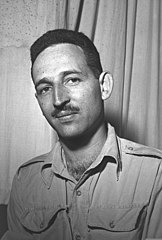Uziel "Uzi" Gal (Hebrew: עוזיאל "עוזי" גל), born Gotthard Glas (15 December 1923–7 September 2002), was a German-born Israeli gun designer, best remembered as the designer and namesake of the Uzi submachine gun.
Biography[]
Gal was born in Weimar, Germany to Mile and Erich Glas. When the Nazis came to power in 1933 he moved first to the United Kingdom and later, in 1936, to Kibbutz Yagur in the British Mandate of Palestine where he changed his name to Uziel Gal. In 1943, he was arrested for illegally carrying a gun and sentenced to six years in prison. However, he was pardoned and released in 1946, serving less than half of his sentence.[1]
Gal began designing the Uzi submachine gun shortly after the founding of Israel and the 1948 Arab-Israeli War. In 1951, it was officially adopted by the Israel Defense Forces and was called the Uzi after its creator. Gal did not want the weapon to be named after him but his request was ignored. In 1955, he was decorated with Tzalash HaRamatkal and in 1958, Gal was the first person to receive the Israel Security Award, presented to him by Prime Minister David Ben-Gurion for his work on the Uzi.
Gal retired from the IDF in 1975, and the following year moved to the United States. He settled in Philadelphia so that his daughter, Tamar, who had serious brain damage, could receive extended medical treatment there.
In the early 1980s, Gal assisted in the creation of the Ruger MP9 submachine gun.[2]
Gal continued his work as a firearms designer in the United States until his death from cancer in 2002. His body was flown back to Yagur, Israel for burial.[3]
References[]
- ↑ Yenne, Bill (2009). Tommy Gun: How General Thompson's Submachine Gun Wrote History. Macmillan. p. 263.
- ↑ "Sturm Ruger MP-9 9 mm sub-machine gun (United States), Sub-machine guns". Jane's Information Group. http://www.janes.com/articles/Janes-Police-and-Homeland-Security-Equipment/Sturm-Ruger-MP-9-9-mm-sub-machine-gun-United-States.html. Retrieved 2010-09-12.
- ↑ "Inventor of Uzi gun dies". BBC. 9 September 2002. http://news.bbc.co.uk/1/hi/world/middle_east/2246368.stm. Retrieved 2 November 2011.
External links[]
- Uziel Gal biography by his son, Iddo Gal
The original article can be found at Uziel Gal and the edit history here.
